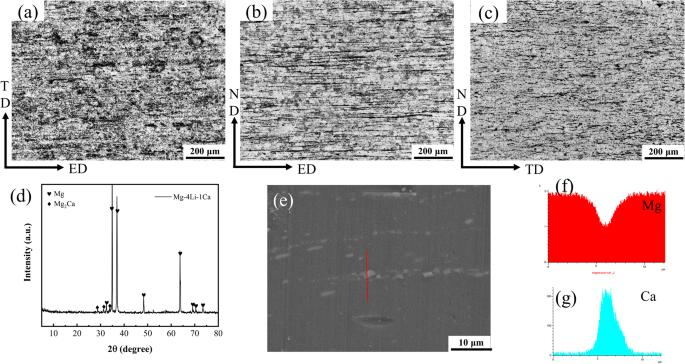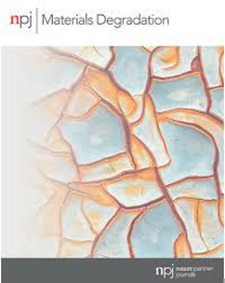Exfoliation of an extruded Mg-4Li-1Ca alloy in presence of glucose and bovine serum albumin
IF 6.6
2区 材料科学
Q1 MATERIALS SCIENCE, MULTIDISCIPLINARY
引用次数: 0
Abstract
Exfoliation corrosion (EFC) on extruded Mg-4Li-1Ca alloys as bone implant materials has not been reported. This study aimed to elucidate the degradation mechanism of a corrosion type-exfoliation occurred on an extruded Mg-4Li-1Ca alloy under the interaction of glucose (Glu) and bovine serum albumin (BSA) in Hank’s solution. The alloy microstructure, chemical composition, texture, stress distribution and Volta potential maps were characterized using metallographic microscopy, scanning electron microscopy and electron backscattered diffraction, and scanning Kelvin Probe. The alloy corrosion behavior was investigated via electrochemical testing and hydrogen evolution rate methods. X-ray diffraction, Fourier transform infrared spectrometry, X-ray photoelectron spectrometer, and fluorescence microscopy were used to analyze the corrosion products and the adsorption of the organic molecules. The experimental results indicated that the anodic second phase (Mg2Ca) were distributed in lamellar and rod-like patterns along the extrusion direction of the alloy, a lower Volta potential for Mg2Ca, texture and residual stresses also promote EFC. An increase in Glu concentration exacerbated the EFC, whereas BSA inhibited the EFC of the alloy. Higher Glu concentrations in BSA in turn inhibited EFC since Glu can complex with amino acids in proteins to form Glu-amino acid amides, which promoted protein adsorption and thereby forming a dense protective film on the alloy surface. The preferential dissolution of the Mg2Ca phase particles led to the complexation and adsorption of Glu and protein. This study enriches the understanding of the corrosion types in biomedical Mg-4Li-1Ca alloy and paving the way for enhancing the EFC resistance of the alloy.

葡萄糖和牛血清白蛋白存在下挤压成型的 Mg-4Li-1Ca 合金的剥离作用
挤压成型的 Mg-4Li-1Ca 合金作为骨植入材料发生剥落腐蚀(EFC)的情况尚未见报道。本研究旨在阐明在 Hank's 溶液中葡萄糖(Glu)和牛血清白蛋白(BSA)的作用下,挤压 Mg-4Li-1Ca 合金发生的腐蚀类型-剥落的降解机制。使用金相显微镜、扫描电子显微镜和电子反向散射衍射以及扫描开尔文探针对合金的微观结构、化学成分、纹理、应力分布和伏特电位图进行了表征。通过电化学测试和氢进化率方法研究了合金的腐蚀行为。利用 X 射线衍射、傅立叶变换红外光谱、X 射线光电子能谱仪和荧光显微镜分析了腐蚀产物和有机分子的吸附情况。实验结果表明,阳极第二相(Mg2Ca)沿合金挤压方向呈片状和棒状分布,Mg2Ca 的伏特电位较低,质地和残余应力也会促进 EFC。Glu 浓度的增加加剧了 EFC,而 BSA 则抑制了合金的 EFC。由于 Glu 能与蛋白质中的氨基酸络合形成 Glu 氨基酸酰胺,从而促进蛋白质吸附,进而在合金表面形成一层致密的保护膜,因此 BSA 中的 Glu 浓度越高,反过来会抑制 EFC。Mg2Ca 相颗粒的优先溶解导致了 Glu 和蛋白质的络合和吸附。这项研究丰富了人们对生物医学 Mg-4Li-1Ca 合金腐蚀类型的认识,为提高合金的抗 EFC 能力铺平了道路。
本文章由计算机程序翻译,如有差异,请以英文原文为准。
求助全文
约1分钟内获得全文
求助全文
来源期刊

npj Materials Degradation
MATERIALS SCIENCE, MULTIDISCIPLINARY-
CiteScore
7.80
自引率
7.80%
发文量
86
审稿时长
6 weeks
期刊介绍:
npj Materials Degradation considers basic and applied research that explores all aspects of the degradation of metallic and non-metallic materials. The journal broadly defines ‘materials degradation’ as a reduction in the ability of a material to perform its task in-service as a result of environmental exposure.
The journal covers a broad range of topics including but not limited to:
-Degradation of metals, glasses, minerals, polymers, ceramics, cements and composites in natural and engineered environments, as a result of various stimuli
-Computational and experimental studies of degradation mechanisms and kinetics
-Characterization of degradation by traditional and emerging techniques
-New approaches and technologies for enhancing resistance to degradation
-Inspection and monitoring techniques for materials in-service, such as sensing technologies
 求助内容:
求助内容: 应助结果提醒方式:
应助结果提醒方式:


